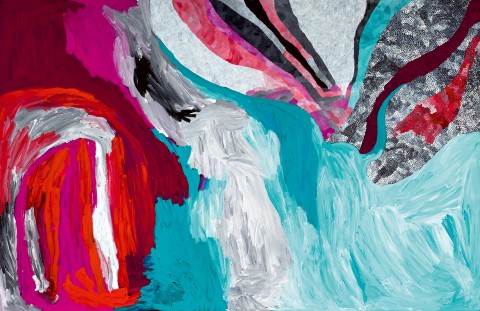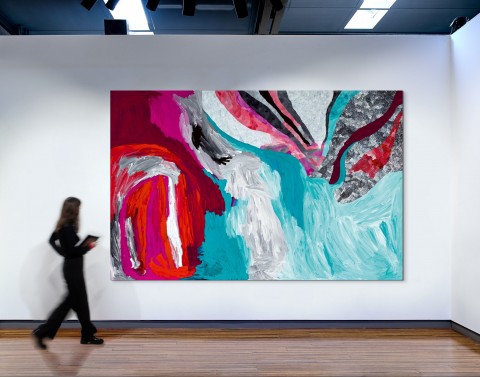PAT AND SALLY’S COUNTRY, 2011
MIRDIDINGKINGATHI JUWARNDA SALLY GABORI, AMANDA GABORI AND ELSIE GABORI
synthetic polymer paint on linen
197.0 x 303.0 cm
bears inscription verso: artists' names, title, date, medium and Mornington Island Art cat no. 7099-L-SG, EG, AG - 0611
MIArt - Mornington Island Art - Mirndiyarn Gununa Aboriginal Corporation, Queensland
Alcaston Gallery, Melbourne
Private Collection, Melbourne
Cairns Indigenous Art Fair 2011, Cruise Line Terminal, Cairns, 19 – 21 August 2011
Artists from Mornington Island, Alcaston Gallery, Melbourne, 13 – 30 September 2011
Mirdidingkingathi Juwarnda Sally Gabori, Fondation Cartier pour l’art contemporain, Paris, 3 July 3 - 6 November 2022
Mirdidingkingathi Juwarnda Sally Gabori, Triennale Milano and Fondation Cartier pour l’art contemporain, Milan, 16 February - 14 May 2023
Ryan, J., & Evans, N., Mirdidingkingathi Juwarnda Sally Gabori, Fondation Cartier pour l’art contemporain, Paris, 2022, pp. 228 - 229 (illus.)
This work is accompanied by a certificate of authenticity from Mornington Island Art which states:
‘This is my country and my husband’s country on Bentinck Island.’ Sally Gabori
‘Amanda and I have really enjoyed painting our parent’s country on Bentinck Island and to do this with our mum has made it even more special.’ Elsie Gabori
‘It feels good to paint with the three of us. A lot different feeling to painting on my own. A special feeling that we share through this painting.’ Amanda Jane Gabori
This collaborative painting by Mirdidingkingathi Juwarnda Sally Gabori and two of her daughters Elsie Gabori and Amanda Jane Gabori is a celebration of the country on Bentinck Island where Sally and her husband, Kabarrarjingathi Bulthuku Pat Gabori spent their early life. In the traditions of the Kaiadilt, they lived off the natural abundance of the surrounding ocean and estuaries on Bentinck Island. A small sparsely vegetated landmass in the southern Gulf of Carpentaria, the island was abandoned by the local people in 1948 following a series of natural disasters. Sally and Pat Gabori, along with the other inhabitants of Bentinck Island, were forced to re-establish their lives at Gununa, on nearby Mornington Island.
Almost sixty years later, in 2005, Sally Gabori, then in her early eighties, was invited to participate with other Kaiadilt in an art workshop at the Mornington Island Art Centre. After a few visits, it became clear that her early paintings – often crude abstract depictions of the myriad of fish found in the surrounding estuaries and sea – offered a unique and colourful expression of her personal and family stories, spawned from the memories of her earlier life. Gabori’s artistic repertory consisted of six main subjects, all of them places on Bentinck Island included Mirdidingki (the place of her birth); Makarrki (her brother King Alfred’s country); Thundi (her father’s country); and Dibirdibi (her husband’s country). By painting each place over and over, she relived memories of the people and places she loved. As Cara Pinchbeck states, ‘Gabori’s works are a celebration of her homeland and illustrate a deep connection to country that has not diminished through separation. From her very earliest works, she has depicted aspects of her own beloved country as well as that of her brother, father and husband – including both geographical aspects of the landscape as well as the wildlife, specifically sea-life which is central to the landscape.’1
Toward the end of her career, Sally Gabori embarked on a series of major collaborative works with her daughters Amanda and Elsie, including this painting. She also encouraged her other daughters into the art centre, creating a space for a new generation of Kaiadilt artists and ensuring a renewal and generational shift for Kaiadilt visual culture.2 Pat and Sally’s Country, 2011 is a monumental example of this shift, a recollection by mother and daughters of both Sally’s homeland Mirdidingki, on the southern edge of Bentinck Island, Pat’s country at Kabararrji which sits next to Sally’s and Dibirdibi, the land of the Rock Cod ancestor. In mythological times, the Rock Cod thrashed about cutting out channels with its ventral fins and carving the South Wellesley Islands from one another.3
Known also as Dibirdibi, this was Pat Gabori’s totemic country with inherited responsibility for the stories and associated places. For Sally and her daughters, these ancestor stories and personal history overlap. Paintings of Dibirdibi depict inland estuarine saltpans, mangrove swamps, rivers, reefs, rock-walled fish traps and hunting grounds that provided an extraordinarily rich set of places with personal and cultural association, providing Sally and her daughters with a wealth of creative inspiration. Whilst much of this major painting contains the varied colours and strong gestural mark-making of Sally Gabori, both Amanda and Elsie, who also had inherited the Dibirdibi totem after Pat’s death, have depicted their personal interpretation of their father’s country. Bands of white, red, purple black and grey colours, painted by Elsie Gabori, sweep down from the central top edge and mimic the variations of the land. Amanda, meanwhile, in the top right hand corner of the canvas, records the delicate scales of the ancient Rock Cod. For both mother and daughters, this canvas is an expression of the love and memory for a husband, father and the landscape of their country, sung in unison.
1. Pinchbeck, C., ‘Mirdidingkingathi Juwarnda Sally Gabori’ in unDisclosed, 2nd National Indigenous Art Triennial, National Gallery of Australia, Canberra, 2012, p. 64
2. McLean, B., ‘Dulka Warngiid; The Whole World’ in Mirdidingkingathi Juwarnda Sally Gabori, Fondation Cartier pour L’art contemporain, Paris, 2022, p. 183
3. McLean, B., ibid., p. 185
CRISPIN GUTTERIDGE

